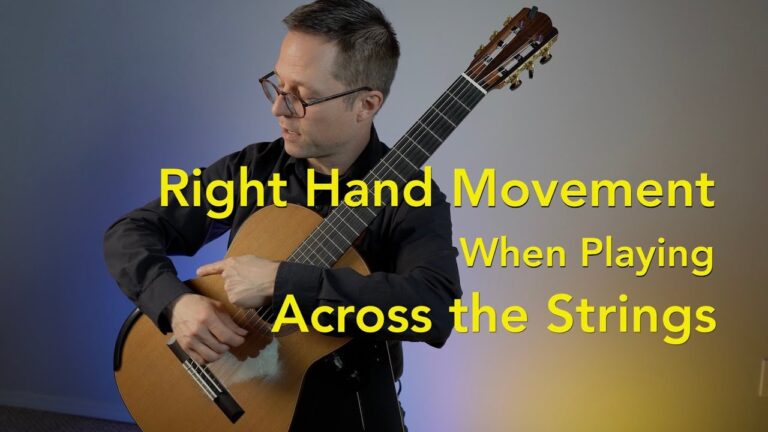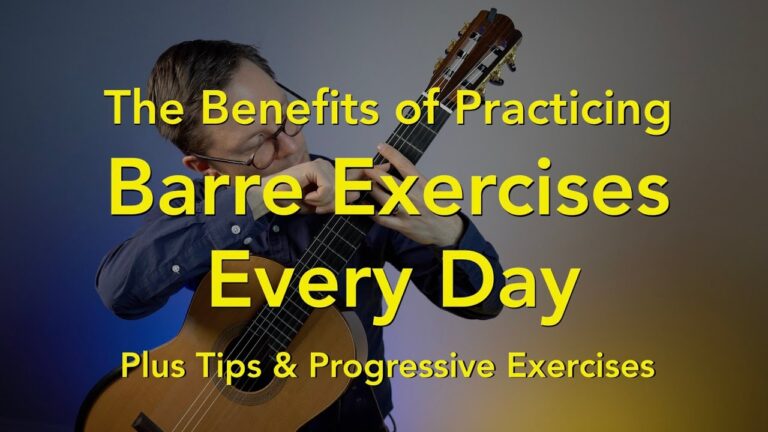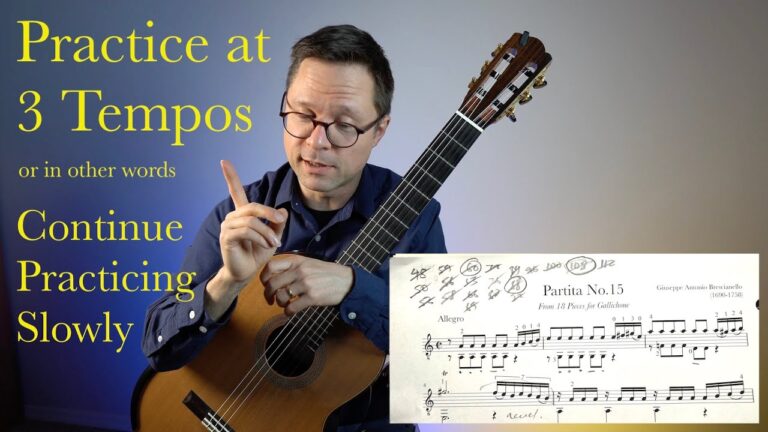Here are a few lessons on right hand alternation for the classical guitar. This is one of the most important concepts of right hand fingering for classical guitar and essential for beginners to accomplish. Intermediate students should also review this because repeating fingers by accident is such a common intermediate mistake. For more free weekly lessons join the Email Newsletter for updates and please consider donating to the site or sharing this post to support.
In the above video I’m using an example exercise (No. 1 – Right Hand Walking) from my PDF eBook 20 Favorite Exercises for Classical Guitar. It’s a great exercise for working on your fundamental right hand technique. Beginner students should just aim for control and go slowly. Never repeat a finger, always alternate. Advanced students may wish to bring the metronome up to 120 beats tot he quarter note. If you don’t know your finger names on your right hand here they are: i = index; m = middle; a = angular (ring finger); p = thumb
The above exercise is from my new book Classical Guitar Technique: Essential Exercises, Scales, and Arpeggios. The 122 page book includes: Practice Routines, Tips, 100 Open String Exercises, 120 Giuliani Arpeggios, Scales, Slur Exercises, Shifts, Finger Independence, Barre, Tremolo, Common Harmonics, and much more.
Practicing open string exercises allows you to focus solely on the right hand and really examine your right hand technique. You might think these exercises are easy but you need to ask yourself: Can I play basic exercises as well as a professional guitarist? Could my legato sound be better? Am I truly relaxed and accurate when I play? Always alternate the fingers in all the combos:
Two finger combinations: i-m / m-i / m-a / a-m / i-a / a-i
Three Finger Combinations: a-m-i / a-i-m / m-i-a / m-a-i / i-a-m / i-m-a
Books to consider
- Classical Guitar Method – Vol. 1, Notation, Video Lessons, 100 pages, Free PDF
- Classical Guitar Method Vol. 2, Notation, Video Lessons, 89 pages.
- Classical Guitar Repertoire Lessons Grade 1 – Eight pieces at the grade one level with dedicated lessons preparing you for each piece.
- Classical Guitar Technique: Essential Exercises, Scales, & Arpeggios – Notation, 122 pages, Gr. 1-9. Video lessons, hundreds of exercises. Includes Giuliani’s 120 arpeggios and 100 open string exercises to learn good fingering habits.
- 20 Favorite Exercises, Notation + TAB, Video lessons, Gr.1-6, Great for crossover or a quick boost.
- Ten Classical Etudes, Gr.4-7, videos lessons, Notation & Notation + TAB





I notice that between Fernando Sor’s studies and Guiliannos, for example, they will quite often, each use different right hand fingering for playing the same arpeggios–maybe even the same songs. I’m concerned that if I’m not consistent in using the same right hand fingerings I will develop bad habits. Should I, for example, be consistently using M and A to alternate on the E string when playing the D string with my thumb? Quite often I will see using fingering that is inconsistent with something like this example, and I don’t know if it’s because the lesson is accommodating players who haven’t reached the level of alternating M and A or is it because it’s a matter of preference? thanks for your advice, Steve
There will always be multiple fingerings that could be considered acceptable for any piece. There is concept and usability and then specific fingering for specific situations. That said, practicing a ton of right hand exercises and technique studies will inform you and train your muscle memory. For example, in my technique book I have 100 open string exercise and also 120 Giuliani studies, after all those your right hand should know pretty clearly what good fingering is versus bad and also be able to navigate some tricky passages. Also, practicing scales with i-m, m-i, m-a, a-m, i-a, a-i and also three finger combos should also get things organized.
Wow, what a great question. If I could chime in as well… I didn’t come to classical guitar until 6 years after playing lots of rock metal folk etc. So for me the diversity of techniques employed has always been strong in my learning across a few styles / within genes. Having said that I fell in love with classical guitars organisational structures particularly in Dexter implementation in both hands; the fact I could learn one modern guitar piece and then straight away apply the learned technique to another modern work was very attractive.
I believe Sor really had a different technique to what we would know consider healthy (don’t quote me on this though) and furthermore it is this very difference that is part of why his music stands out compared to other ‘guitarist composers’ of the 19th century, his technical eccentricities often but not always influenced his note choices, particularly in arpeggio and block harmonies. I think that if you want to play Sor in depth including one off learning of any of his master works I would learn his fingering and create diversity in my right hand. Learning this way is possible if you think of the new technique as part of learning the work and thus frame your conscious activities around the written marking and allow this to slowly influence your subconscious activities such as muscle memory as part of this memorised work.
Having said all of that, plenty of guitarists play fantastic musical interpretations of Sor’s work without the extra fuss but the best and most listenable interpretations in my opinion are those that learn to play like Sor.
I guess the only question is: how much do you want to sound like Sor?
Examples of a great listen:
William Carter (SACD)
Kazuhito, Yamashita. Sor duets (double disk)
Thanks for that exercise pdf in the last newsletter, its has been very useful with my students.